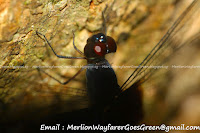Lower Peirce Reservoir
North, Singapore
March 2015
On the fringes of the forest, this is a common sight - A pack of Macaca fascicularis (Long-Tailed Macaque) basking in the sun. Being a complete family unit, the pack consisted of the alpha male, several females, and young, some of whom were still carried by their mothers.
Oblivious to the danger, a jogger runs by with her young child in a pram.
She stops to point out the "cute monkeys" to her toddler...
In a Straits Times report ("Monkey see, monkey do: 5 monkey hot spots in Singapore"), Upper Thomson was listed as a "monkey spot". Residents reported incidents where monkeys smashed their flower pots, gnawed through water containers, upset pots of plants and stole fruit from the trees they planted.
Most macaques are non-aggressive, as long as they are not threatened and food is not carried in front of them. Once past the danger post by them, a regular visit to Lower Peirce Reservoir is always a treasure trove of small finds.
A curious female Telamonia festiva (Jolly Telamonia) peers from bneath a leaf...
A moth caterpillar balances itself at the edge of the stem...
This bug is big - With legs extended, it was almost the size of a human palm...
If you see a beetle with bright yellow spots on its back but much larger in size than a typical ladybird beetle and having a slightly more elongated body, it may be a fungus beetle. Fungus beetles, as the name implies, are affiliated with fungus. However, they are not always seen on fungus as they do fly around and land on some other surfaces. They belong to the family Endomychidae, commonly called Handsome Fungus Beetles.
The Lower Peirce version of Eumorphus quadriguttatus (Handsome Fungus Beetle)...
A male Tyriobapta torrida (Treehugger) Dragonfly from Libellulidae family. They are found in forest swamps and near waterways, guarding small territories in shaded areas...
A juvenile Argiope (St Andrew's Cross Spider) resting in a dark corner...
A cheeky Chrysilla lauta (Elegant Golden Jumper) Male Spider glaring back...
A grasshopper-like Cicadellidae (Leafhopper) resting in a very prominent location with the colour contrast...
March is certainly the spiderling season with lots hatching. On the web, dew drops can be seen collecting in big puddles...
A delicate damselfly rests by the water edge...
An Ampullariidae (Apple Snail) slowly gliding along a stalk...
A parting tribute to Mr Lee as the skies turned dark with rain clouds...
Sources



































